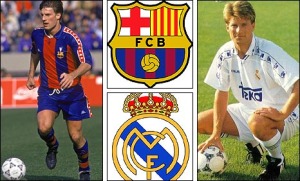The first of the Clásico Heartbreakers we looked at specialised in scoring goals; the second was a master of creating them…
Clásico appearances: 21 (17 Barcelona, 4 Real Madrid)
Clásico goals: 2 (both Barcelona)
Barcelona record: W6 D4 L7
Real Madrid record: W1 D1 L2
Poster boy of the “Danish Dynamite” national team of the 1980s, Michael Laudrup was one of the most gifted footballers of recent history. He boasted superb technical ability, combined with unparalleled elegance as well as a tendency to find space and team-mates effortlessly. Despite shooting to world fame for his exploits with an overachieving national team at Euro ’84 and the World Cup of 1986 in Mexico, he never really succeeded at Juventus where the pressure to replace Michel Platini was too great.
Barcelona, in 1989, weren’t at their best either. Legendary ex-player Johan Cruyff had taken over at the start of the 88/89 season. While he brought silverware in the form of the Cup Winners’ Cup, Real Madrid were dominating on the domestic front; claiming the Copa del Rey in addition to the league title (astonishingly, their fourth in a row). However, one of the greatest periods of Barcelona’s history was imminent and the 25 year-old Danish schemer whom he brought to the club was to be the crown jewel of his team.
The success wasn’t immediate. Madrid won a fifth consecutive league title in 89/90 and, while beaten 2-0 by Barça in the Copa del Rey final, sent out a signal of intent with a 5-1 aggregate win over the Catalans in the new season’s Supercopa. But it was not a sign to things to come as Barcelona cruised to a title win, ten points clear of second-placed Atlético Madrid and eleven clear of Real in third. Laudrup came to the fore, pulling all the strings and finding a goalscoring touch which had eluded him in Italy. Here’s his spectacular volley from a 2-1 Clásico win at the Camp Nou.
Clásico goals: 2 (both Barcelona)
Barcelona record: W6 D4 L7
Real Madrid record: W1 D1 L2
Poster boy of the “Danish Dynamite” national team of the 1980s, Michael Laudrup was one of the most gifted footballers of recent history. He boasted superb technical ability, combined with unparalleled elegance as well as a tendency to find space and team-mates effortlessly. Despite shooting to world fame for his exploits with an overachieving national team at Euro ’84 and the World Cup of 1986 in Mexico, he never really succeeded at Juventus where the pressure to replace Michel Platini was too great.
Barcelona, in 1989, weren’t at their best either. Legendary ex-player Johan Cruyff had taken over at the start of the 88/89 season. While he brought silverware in the form of the Cup Winners’ Cup, Real Madrid were dominating on the domestic front; claiming the Copa del Rey in addition to the league title (astonishingly, their fourth in a row). However, one of the greatest periods of Barcelona’s history was imminent and the 25 year-old Danish schemer whom he brought to the club was to be the crown jewel of his team.
The success wasn’t immediate. Madrid won a fifth consecutive league title in 89/90 and, while beaten 2-0 by Barça in the Copa del Rey final, sent out a signal of intent with a 5-1 aggregate win over the Catalans in the new season’s Supercopa. But it was not a sign to things to come as Barcelona cruised to a title win, ten points clear of second-placed Atlético Madrid and eleven clear of Real in third. Laudrup came to the fore, pulling all the strings and finding a goalscoring touch which had eluded him in Italy. Here’s his spectacular volley from a 2-1 Clásico win at the Camp Nou.
With the temperamental but brilliant strike duo of Hristo Stoichkov and Romário joining Barcelona, they went on to win a further four league titles and, in 1992, the club’s first ever European Cup. The pair have constantly paid tribute to the playmaking ability of Laudrup, giving them a constant supply of killer balls to feed on; watch him, at about 1:30, lay on the third of Romário’s hat-trick in a 5-0 drubbing of Madrid in January 1994.
However, with Netherlands defender Ronald Koeman also in the side, Barcelona were forced to rotate (as only three foreigners could be played in a match). With manager Cruyff electing to leave Laudrup on the bench for the 1994 final of the newly-branded Champions League, his team were destroyed 4-0 by a ruthless Milan (whose manager, Fabio Capello, admitted after the game that he was relieved at not having to deal with the opposition’s star player).
This surely pointed to deeper problems. Known for being unselfish on the pitch, Laudrup was somewhat more difficult off it. An unwillingness to adapt to the pragmatic style of Denmark manager Richard Møller Nielsen meant that Laudrup and his younger brother Brian walked out on the national team in November 1990. Brian returned in April 1992; shortly before Denmark were awarded a place in Euro ’92 at the expense of warring Yugoslavia. He would provide the creativity to a side who, against all odds, took home the European Championships. Michael Laudrup had to settle for watching his country’s greatest footballing achievement from afar.
Inevitably, one club (even if it’s mes que un club) wouldn’t be big enough for the egos of both Laudrup and Johan Cruyff. The Dutchman was sometimes dismayed at Laudrup’s tendency to go missing for much of a match – another penchant, for providing game-changing moment of magic, perhaps made this more infuriating. Both parties have since played down talk of a falling out, so Laudrup’s next action can’t really be pinned down just to this. But after the Champions league snub, he shocked the football world by moving on a free transfer to Barcelona’s biggest rivals, Real Madrid.
While only being in the Spanish capital for two years, the maestro’s impact was keenly felt. He inspired Real to a 5-0 win in his first Clásico in a white shirt; ironically, a year on from Barca’s identical victory. A gracious Cruyff couldn’t help but praise his former protégé and Madrid would go on to win La Liga, making Laudrup the first player to win five consecutive league titles with two different teams.
The level of animosity levelled at Laudrup during his two visits to the Camp Nou while playing for Los Merengues was incredible. The jeers from the crowd in the footage below (supposedly from Laudrup’s very last Clásico in February 1996, though the commentary suggests otherwise) are only outdone by the look of embarrassment on Laudrup’s face as his former mentor refuses to give him the ball for a throw-in.
Whether or not he actually made the remarks which the commentator in the video alludes to, time healed the scars. Of all the great players who switched between the two clubs, Michael Laudrup remains the one who is still loved by both sets of fans. Even after his spell in Madrid, Barcelona fans couldn’t continue to hate the man who played such a key part in the club’s history. Laudrup, asked where his allegiance now lies, simply replied “They are my two teams, both of them.”
He has more La Liga winners’ medals than anyone else who features in this series, but that’s not even the most fitting accolade to his brilliance. It’s the constant tributes gushing from those who played alongside him, unreservedly acknowledging his ability to bring the best out of others. And if you need evidence of that, look no further than two of his biggest fans. Romário, his Barcelona team-mate and Spain’s Pichichi (top scorer) in 1994; and Iván Zamorano, his Real Madrid team-mate and Pichichi in 1995. Michael Laudrup is perhaps the greatest of the Clásico Heartbreakers.
Plays like…
Described by Andrés Iniesta as “the greatest player in history”, it’s easy to see how Laudrup has influenced the Barcelona midfielder’s game. Both are graceful players, with a peerless reading of the game and the ability to produce magic in the final third. But whereas Laudrup had a mercurial side, capable of drifting out of the game and not contributing much defensively, Iniesta is a tireless worker who uses his energy to close down opponents. When he and Xavi are played side-by-side, it’s inevitable that they will dominate possession. Maybe a closer fit is Real Madrid’s Kaká; a true number ten who may not always control the game but, when on song, has the skill and invention to unpick the meanest of defences.
–Ihsaan Budaly
We are previewing El Clasico,with a series of articles all of which you can read here
If you like our blog,then do vote for us here.










Recent Comments